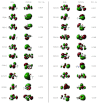Two-dimensional stimulated resonance Raman spectroscopy of molecules with broadband x-ray pulses
- PMID: 22583220
- PMCID: PMC3356307
- DOI: 10.1063/1.4706899
Two-dimensional stimulated resonance Raman spectroscopy of molecules with broadband x-ray pulses
Abstract
Expressions for the two-dimensional stimulated x-ray Raman spectroscopy (2D-SXRS) signal obtained using attosecond x-ray pulses are derived. The 1D- and 2D-SXRS signals are calculated for trans-N-methyl acetamide (NMA) with broad bandwidth (181 as, 14.2 eV FWHM) pulses tuned to the oxygen and nitrogen K-edges. Crosspeaks in 2D signals reveal electronic Franck-Condon overlaps between valence orbitals and relaxed orbitals in the presence of the core-hole.
Figures













References
-
- Marangos J., “Introduction to the new science with x-ray free electron lasers,” Contemp. Phys. 52, 551 (2011).10.1080/00107514.2011.607290 - DOI
-
- Popmintchev T., Chen M., Arpin P., Murnane M. M., and Kapteyn H. C., “The attosecond nonlinear optics of bright coherent x-ray generation,” Nat. Photonics 4, 822 (2010).10.1038/nphoton.2010.256 - DOI
-
- Adams B., Nonlinear Optics, Quantum Optics, and Ultrafast Phenomena with X-Rays (Springer, 2003).
-
- Tanaka S. and Mukamel S., “Probing exciton dynamics using Raman resonances in femtosecond x-ray four-wave mixing,” Phys. Rev. A 67, 033818 (2003).10.1103/PhysRevA.67.033818 - DOI
-
- Mukamel S., Principles of Nonlinear Optical Spectroscopy (Oxford University Press, New York, 1995).
Publication types
MeSH terms
Substances
Grants and funding
LinkOut - more resources
Full Text Sources
Other Literature Sources

